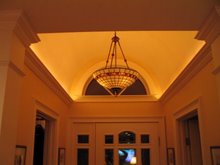Built-In Bookcase And Mantle Installation
Installing the Bookcase Back Panel:
Once I have the carcase assembled I square the case and add a 1/4″ maple plywood back to the bookcase. The plywood back helps square the case as well as give it strength. I like to use 3/4″ staples and wood glue to attach the back panel.
Because the bookcase is against the mantle and the TV panel I did not have to worry about the back plywood panel edge showing. If this was a concern I would have used a dado blade on the table saw to cut a rabbit cut to hide the plywood.
After dealing with the back panel I fill any nail holes and defects that will show and give the bookcase carcase a good sanding. It’s easier to sand the case at this point prior to installing the face frame.

Making the Face Frame:
I also used the story pole to layout and make the face frame. All face frame and shelf nosing trim was done with paint grade poplar wood. I like poplar, its a hard, durable wood, easy to work with and usually has no knots.
Prior to gluing any bookcase components together everything gets a clean and straight edge on the joiner. Doing this now makes for tighter glue joints and easier sanding of mill glaze later.
One of the most common methods of building a built in bookcase involves using a face frame, which is an assembly of vertical and horizontal wood slats, typically 1×3’s. The face frame is attached to the front of a plywood case. Using a face frame construction on built-ins is a popular design in older homes and traditional settings.

I use a biscuit joiner to cut slots in to the face frame for wood biscuits. A biscuit joiner, also known as a plate joiner is a tool used to join two pieces of wood together. It uses a 4″ diameter carbide tipped circular blade to cut a crescent shaped slot or hole in two opposing pieces of wood. A wood biscuit is then inserted in the slot with wood glue and the assembly is clamped.
Wood biscuits are made from compressed beechwood and are often called Wood Plates or Wafers. Wood biscuits are used for edge or corner-jointing. The wood biscuits are fitted into slots usually created with a biscuit joiner. The biscuits add strength to the face frame, especially prior to installing it. The secret behind using a biscuit is when it comes into contact with a water based glue it swells and creates a tight locked joint. Once all of the biscuit slots are cut I insert the biscuits and dry fir the face frame prior to gluing and clamping. A quick check with the story pole ensures that I stay on track.




















